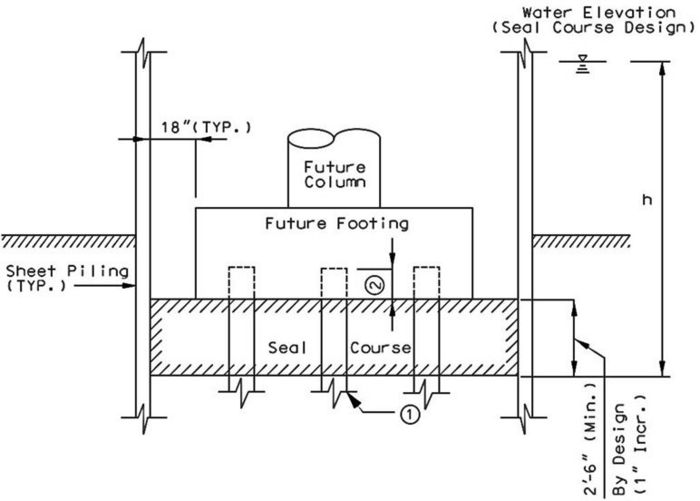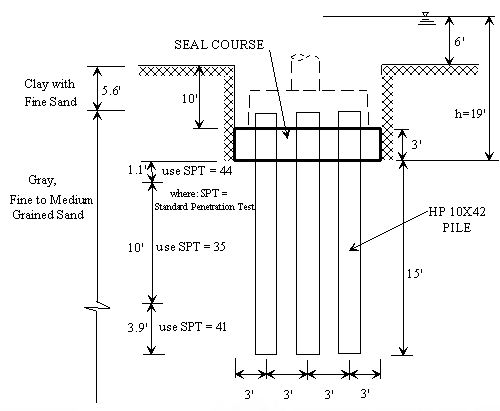751.39 Pile Footings: Difference between revisions
m Per Bridge, much of the article was updated to conform with LRFD practices. |
m Per Bridge, minor clarification |
||
| Line 1: | Line 1: | ||
[[Image:751.39 | [[Image:751.39.jpg|right|thumb|700px|<center>'''Notes:''' <br>''' 1)''' All pile shall be vertical. <br> | ||
'''2)''' | '''2)''' Use 12” for Seismic Design Category A or 18” for Seismic Design Category B, C and D <br> | ||
12” for | per AASHTO Guide Specifications for LRFD Seismic Bridge Design.</center> ]] | ||
Revision as of 08:51, 21 November 2012

1) All pile shall be vertical.
2) Use 12” for Seismic Design Category A or 18” for Seismic Design Category B, C and D
per AASHTO Guide Specifications for LRFD Seismic Bridge Design.
751.39.1 General Requirements
Water elevation is to be determined for the site conditions by the preliminary design section; generally, less than the average of high and low water.
Determine the factored uplift load per pile by deducting the weight of the seal course and friction between seal course and sheet piling of cofferdam from the uplift force produced by the hydrostatic head "h".
Use a friction value between the seal course and the sheet piling of 2 lbs./in2 acting on (perimeter x depth) of seal course.
Factored uplift load per pile =
- Load factor for uplift x (Uplift force of water – Weight of seal course – Friction between seal course & sheet piling) / No. of piles
751.39.2 Pile Pull-out Force
Maximum factored resistance per pile shall be determined by the minimum of:
- (1) Factored resistance for skin friction = Geotechnical resistance factor for skin friction x Nominal skin friction resistance
- Use "DRIVEN" program to calculate nominal skin friction resistance of pile (without tip resistance).
- Geotechnical resistance factor for skin friction, φup. from LRFD Table 10.5.5.2.3-1
- Use φup = 0.2 from LRFD table 10.5.5.2.3.-1 for single pile unless higher resistance factor can be justified based on soil type and test method.
- (2) Factored resistance for pile tension = Structural resistance factor for pile tension x Yield strength of steel x Steel area of pile.
- Note: Since CIP pile is not filled at this stage, use steel pipe pile area without concrete to determine the factored resistance for pile tension. ASTM 252 allows “the wall thickness at any point shall not be more than 12.5% under the specified nominal wall thickness. For steel pipe pile area computation consider 87.5% of wall thickness.
- Structural resistance factor for pile tension, φy = 0.25
- (3) Factored resistance for 10 psi adhesion = structural resistance factor for 10 psi adhesion x 10 psi x Pile perimeter x Depth of seal course
- Structural resistance for 10 psi pile adhesion, Φ3 = 1.0
- For HP pile perimeter use 2*(Depth + Width) of HP shape.
Plan Reporting
Seal Course size shall be shown on the plans as designed.
Seal Courses are typically designed for one footing only. They may be designed for uplift loads developed under more than one footing or where there is economy of scale in constructing a larger cofferdam, for example:
- (1) where individual seal courses are proximate and costlier than considering one large seal course under more than one footing, and
- (2) where removal of an existing footing requires a larger cofferdam to be constructed enclosing both existing and new locations of footings with the result that a larger than usual seal course size may be less costlier than individually constructed cofferdams.
Where a seal course is to be designed to resist the uplift loads resulting from the proposed construction of more than one footing, the plans should show or indicate that more than one footing was considered in designing the seal course and the pay item adjusted accordingly.
Seal Course size shown on plans should not be allowed to be resized as in combining adjacent seal course(s) or lessening thickness without approval from either the Structural Project Manager or Structural Liaison Engineer and an official change order request from district Construction and Materials Division.
751.39.3 Example: LRFD Seal Course Design
Check if Seal Course design is adequate.
Given
- Concrete Strength f'c= 3000 psi
- Pile spacing = 3'-0"
- 12 - HP 10 x 42 piles
- Area of an individual HP 10 x 42 Pile = A = 12.4 in2
- Depth of HP shape = 9.7 inch
- Width of HP shape = 10.1 inch
- Yield strength of steel Fy = 36 ksi
- Maximum axial load Py = Fy (A) = 36 ksi (12.4 in2) = 446.4 kips
- Hydrostatic head h = 19'
- Seal Course = 12' x 15' x 3'
- Pile embedment below seal course = 15'

Solution
Factored uplift load per pile:
| Uplift force of water = 12'(15')(19')(0.0624 kips/ft3) | = 214 kips |
| Weight of seal course = 12'(15')(3')(0.15 kips/ft3) | = -81 kips |
| Friction of sheet pile = (15'+12')(2)(3')(144)(0.002kips/in2) | = -47 kips |
| Net uplift of piles | = 86 kips |
| Factored uplift load per pile = 86 kips/12 piles = 7.17 kips/pile | |
Maximum factored resistance:
Use the minimum of:
(1) Factored resistance for skin friction = Geotechnical resistance factor for skin friction x Nominal skin friction resistance:
- Using "DRIVEN" program, Nominal skin friction resistance of pile is 53.97 kips.
- Geotechnical resistance factor for skin friction = 0.2 for uplift resistance of single pile from LRFD 10.5.5.2.3-1 (Conservatively assumed 0.2),
Factored resistance for skin friction = 0.2 x 53.97 kips = 10.79 kips
(2) Factored resistance for pile tension
- = 0.25 x Fy x Steel area of pile
- = 0.25 x 36 x 12.4
- =111.6 kips
(3) Factored resistance for 10 psi adhesion = Structural resistance factor for 10 psi pile adhesion x 10 psi x Pile perimeter x Depth of seal course
Structural resistance for 10 psi pile adhesion, Φ3 = 1.0
= 1.0 x 10/1000*2 x (9.7+10.1) x 3 x 12
= 14.26 kips
Minimum from (1), (2) & (3):
Maximum factored resistance = 10.79 kips
Factored uplift load per pile = 7.17 kips
7.17 kips ≤ 10.79 kips, O.K.
Try seal course depth = 2'-6"
Factored uplift load per pile :
| Uplift force of water | = 12'(15')(18.5')(0.0624 kips/ft3) = 207.8 kips |
| Weight of seal course | = 12'(15')(2.5')(0.15 kips/ft3) = -67.5 kips |
| Friction of sheet pile | = (15'+12')(2)(2.5')(144)(0.002 kips/in2) = -38.9 kips |
| Net uplift of piles | = 101.4 kips |
| Factored uplift load per pile | = 101.4 kips/12 piles = 8.45 kips/pile |
Maximum factored resistance :
Use the minimum of:
(1) Factored resistance for skin friction
- = Geotechnical resistance factor for skin friction x Nominal skin friction resistance
- = 0.2 x 53.97 kips = 10.79 kips
(2) Factored resistance for pile tension = 111.6 kips
(3) Factored resistance for 10 psi pile adhesion = Structural resistance factor for 10 psi pile adhesion x 10 psi x Pile perimeter x Depth of seal course
Structural resistance factor for 10 psi pile adhesion, Φ3 = 1.0
= 1.0 x 10/1000*2 x (9.7+10.1) x 2.5 x 12
= 10.88 kips
Minimum from (1), (2) & (3):
Maximum factored resistance = 10.79 kips
Factored uplift load per pile = 8.45 kips
8.45 kips ≤ 10.79 kips, O.K.
(Using a depth of 2'-6" is an economical design.)